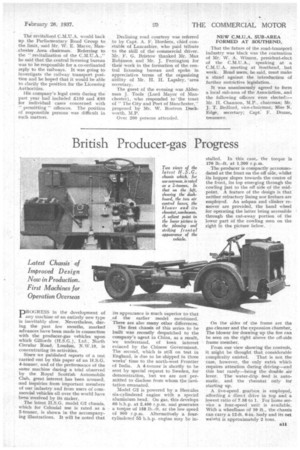British Producer-gas Progress
Page 45

If you've noticed an error in this article please click here to report it so we can fix it.
Latest Chassis of Improved Design Now in Production. First Machines for Operation Overseas PROGRESS in the development of any machine of an entirely new type is inevitably slow. Nevertheless, during the past few months, marked advances have been made in connection with the producer-gas vehicles upon which Gilfords (H.S.G.), Ltd., North Circular Road, London, N.W.10, is concentrating its activities.
Since we published reports of a test carried out by this paper of an H.S.G. 4-tonner, and of the performance of the same machine daring a trial observed by the Royal Scottish Automobile Club, great interest has been aroused, and inquiries from important members of our industry and from users of commercial vehicles all over the world have been received by its maker.
The latest H.S.G. model G2 chassis, which for Colonial use is rated as a 2-tonner, is shown in the accompanying illustrations. It will be noted that its appearance is much superior to that of the earlier model mentioned. There are also many other differences.
The first chassis of this series to be built was recently despatched to the company's agent in China, as a result, we understand, of keen interest evinced by the Chinese Government. The second, Which is still on test in England, is due to be shipped in three weeks' time to the north-west Frontier of India. A 4-tormer is shortly to be sent by special request to Sweden, for demonstration, but we are not permitted to disclose from whom the invitation emanated.
Model G2 is powered by a Hercules six-cylindered engine with a special aluminium head. On gas, this develops b.h.p. at 2,400 r.p.m. and generates a torque of 158 lb.-ft. at the low speed of 900 r.p.m. Alternatively a fourcylindered 55 b.h.p. engine may be in stalled. In this case,_ the torque is 170 lb.-ft, at 1,2013 r.p.m.
The producer is compactly accommodated at the front on the off side, whilst its hopper slopes towards the centre of the front, its top emerging through the cowling just to the off side of the midpoint. A feature of the design is that neither refractory lining nor firebars are employed. An ashpan and clinker remover are provided, the hand wheel for operating the latter being accessible through the cut-away portion of the lower part of the cowling seen on the right in the picture below.
On the sides of the frame arc the gas cleaner and the expansion chamber. The blower for drawing up the fire can be seen on the right above the off-side frame member.
From our view showing the controls, it might be thought that considerable complexity existed. That is not the case, however, the only extta which requires attention during driving—and this but rarely—being the double air lever. The water-drip feed is automatic, and the rheostat only for starting up.
A five-speed gearbox is employed, affording a direct drive in top and a lowest ratio of 7.58 to 1. For home service a four-speed unit is available. With a wheelbase of 10 ft., the chassis can carry a 12-ft. 6-in, body and its net weiaht is approximately 2 tons.




























































































